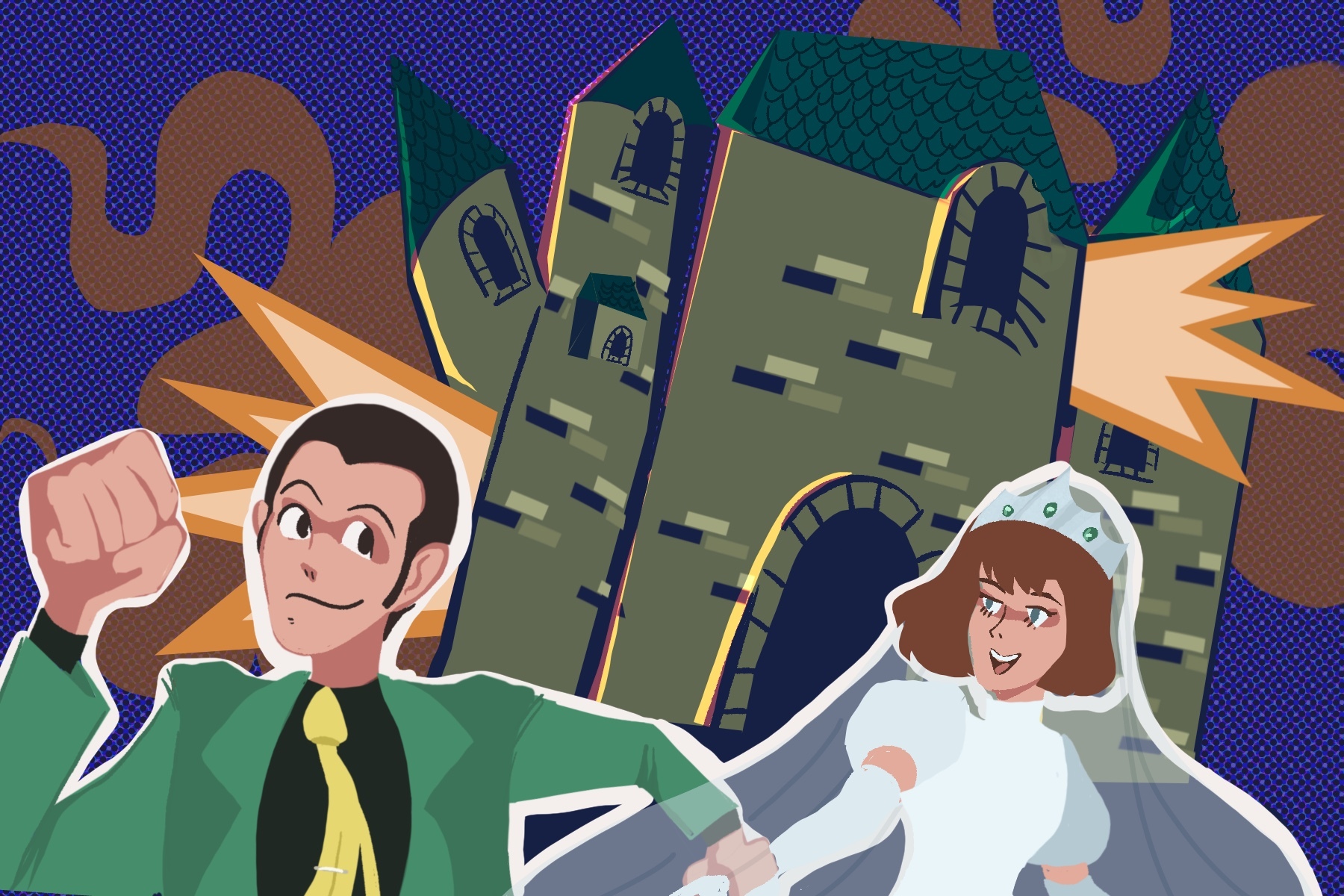For nearly four decades, Studio Ghibli has released many of the greatest films in the anime industry. The studio has garnered the reputation of being an artistic and technical powerhouse. Its many talented artists and directors have strived to maintain this reputation over the years. However, few have aided this pursuit as much as Hayao Miyazaki. He is often recognized for co-founding Studio Ghibli and directing many of its best films. However, his most significant contribution to the studio predates its founding in 1985. Six years earlier, in 1979, Miyazaki crafted a blueprint for his later films with “Lupin III: The Castle of Cagliostro.”
“Lupin the Third” and Miyazaki’s Film Origins
Miyazaki’s involvement with “The Castle of Cagliostro” and the “Lupin the Third” franchise has a unique history. His first major success was the 1971 anime series “Lupin the Third: Part 1,” which he co-directed alongside Masaaki Ōsumi and Isao Takahata. The series depicts the criminal adventures of the titular Arsène Lupin III, the grandson of Maurice Leblanc’s famous fictional thief, Arsène Lupin. Each episode follows Lupin III as he embarks on various heists and assassinations while running from the International Police and numerous criminal organizations. Each episode provides entertaining storylines defined by their slapstick humor, clever writing and memorable characters. While the series targeted a much older audience than Miyazaki’s later work, notably being one of the earliest examples of adult anime on television, it demonstrated his ability to deliver light-hearted yet exciting stories. As a result, he would be chosen to direct the franchise’s second theatrical film, “The Castle of Cagliostro.”
The film follows Lupin and his gang of thieves on their journey through the fictional country of Cagliostro. They arrive in search of a secretive manufacturer of counterfeit currency. However, they soon discover the plot of a villainous count who intends to marry the country’s princess, thereby becoming its king and gaining access to the royal castle’s hidden treasure. With this revelation, the group sets out to intervene in the count’s plans while searching for the source of the counterfeit bills.
Miyazaki’s increased creative influence over “The Castle of Cagliostro” allowed the film to stand apart from any other entry in the “Lupin the Third” franchise. Unlike the mature spy-thriller formula of the original television series, the film adopts a light-hearted tone that tempers the series’s adult content. Instead, it delivers a family-friendly story more akin to “Indiana Jones” than “James Bond.” Despite these changes, the film successfully combines humor with compelling drama that often surpasses the original series. The count of Cagliostro is a simplistic villain, yet his ruthless personality gives him a threatening presence. The mysteries surrounding the printed currency and the castle’s hidden treasure creates intrigue that prevents the story from suffering through any dull moments.
“The Castle of Cagliostro” also provides a light-hearted reimagining of the traditional “Lupin the Third” cast. While the original anime and manga series characterized its protagonist as a greedy womanizer and remorseless killer, the film presents a slightly older and wiser version of Lupin that has grown out of his previous vices. Miyazaki described his interpretation of the character in a 1981 interview by stating, “Lupin lived in his glory in the 60s and early 70s, now living the regret and shame for his young and wild life.” As with the rest of the film’s narrative elements, Miyazaki’s version of Lupin successfully appeals to a broader audience without betraying the character’s original personality.
Despite the film’s connections to the “Lupin the Third” franchise, its visuals and settings are powerfully reminiscent of Miyazaki’s later work. Cagliostro is far more grounded than the imaginative settings of “Spirited Away” and “Howl’s Moving Castle,” yet it shows an impressive degree of detail and variety. Its sunny hillside roads and nighttime city streets host frenetic chase scenes, while moss-covered ruins and rustic farms provide beautiful backgrounds to the film’s quieter moments. Miyazaki consistently uses vividly colorful backgrounds to bring the fictional country to life in every scene.
The film’s most excellent artistic highlight is its titular castle. Its lofty towers and ancient design contrast with the modernity of typical Lupin settings. Instead, its fairy-tale aesthetic is reminiscent of early Disney works. However, the monumental castle’s location in the middle of the lake transforms it into an intimidating sight. The interior reinforces these impressions with its initially luxurious halls and bedrooms, while the perilously steep rooftops and underground catacombs reveal its dangerous secrets through exciting action scenes.
“The Castle of Cagliostro” demonstrated Miyazaki’s strengths as a filmmaker. Its fluid animation, unique environments and excellent pacing stood out among many other animated films in the 1970s. By straying so heavily from the “Lupin the Third” franchise, audiences did not view the movie as another entry in the series. As a result, Miyazaki’s talent was extensively acknowledged and praised rather than overshadowed by the stature of the massive franchise. The film’s success ultimately marked the beginning of Miyazaki’s outstanding career in animated filmmaking.
Cagliostro’s Influence on Ghibli’s Debut
Despite being Miyazaki’s first attempt at directing a feature-length film, “The Castle of Cagliostro” was well-received by critics and audiences alike. However, in an interview with Animage Magazine, he expressed a desire to improve the film, stating, “I also have so many bitter memories and regrets about that movie.” Although he wouldn’t direct another “Lupin the Third” film, many elements of “The Castle of Cagliostro” would be refined in Studio Ghibli’s first film: “Castle in the Sky.”
The movie follows the journeys of two children. The first is Pazu, a boy who seeks to prove his father’s discovery of a floating castle named “Laputa.” The second is Sheeta, a girl descended from a royal family who possesses an amulet with strange powers. Due to the unknown nature of these powers, she is hunted by military forces who intend to use the amulet for unknown purposes. Eventually, the deuteragonists cross paths and work together to stop the military’s plans while uncovering the amulet’s connection to Laputa.
On the surface, “Castle in the Sky” shares many similarities with Miyazaki’s first film. Major key plot points are present in both films, such as the significance of the princess’s family heirloom and the reveal of certain plot twists. Even the opening credits sequences use similar methods of showcasing each film’s setting. However, “Castle in the Sky” differs from Miyazaki’s first film by fully showcasing his artistic and narrative talents. Unlike the grounded European backdrop of Cagliostro, the world of “Castle in the Sky” offers a creative blend of steampunk and fantasy. The film presents airships as a common means of travel for wealthy elites, government forces and criminal gangs. In contrast, those who live on the ground reside in small mining towns where the workers operate fictional machinery that’s detailed enough to seem real.
However, Miyazaki’s creative world-building is best illustrated through the film’s namesake. Laputa’s monumental stone architecture is overtaken by nature, with a giant tree sprouted in its center. Its appearance alone informs the audience about the castle’s ancient origins, while its ability to hover above the seemingly more advanced airships hints toward its hidden technology. “The Castle of Cagliostro” demonstrated a similar practice of integrating narrative into its environmental design, yet “Castle in the Sky” builds upon this concept by abandoning the former’s realistic setting. The lack of connection to the real world results in new and fascinating locations, visually and in the storyline. While Miyazaki’s debut film was fantastic, “Castle in the Sky” improved the narrative with its heightened creativity and polished storytelling. Furthermore, it proved audiences had yet to see the full extent of Miyazaki’s talents and imagination.
Influence on Later Works
“The Castle of Cagliostro” and “Castle in the Sky” allowed Miyazaki to forge a path for the future of Studio Ghibli. These early films appealed to broad audiences with likable characters and simple yet engaging stories. Each film also embodied Miyazaki’s artistic passions and talent, crafting believable settings that would become more detailed and imaginative as Studio Ghibli refined its craft with later projects. It’s unlikely the studio would have developed the same reputation it holds today without “The Castle of Cagliostro.” The film served as a prototype for many of the studio’s early works by demonstrating Miyazaki’s capabilities while still leaving room for growth and refinement. Because of this, the movie is still worth watching today as both a landmark in Studio Ghibli’s history and a fantastic movie on its own merits.

















